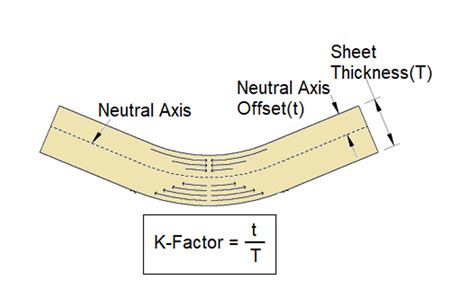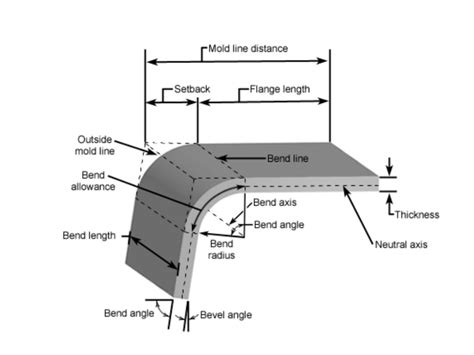k factor sheet metal Effortlessly calculate K-Factor for sheet metal bending with our free online calculator. Save time and improve accuracy. Try it now! That is a phone nid or rocker block, it is used to produce dial tone on all phone lines, looks like they are using cat5 or 6 ethernet that is converted to be used for phone.Roof battens, or furring strips, are thin strips of wood, plastic or metal that are used to provide a fastening point for the roofing material. They are most often used with clay, stone, or concrete tiles. Cool Roof. Any roof that is designed to reflect more sunlight and absorb less heat than a .
0 · sheet metal k factor definition
1 · sheet metal bending radius chart
2 · k factor sheet metal calculator
3 · k factor for stainless steel
4 · how to calculate k factor
5 · bending calculation for sheet metal
6 · bending allowance in sheet metal
7 · bend allowance k factor chart
Each junction box is rated by amps to protect you, the circuit, and the junction box. It is critical to have the box with the proper amp ratings. For example, a radial circuit needs a 30 amp box, while a lightning circuit needs a 20 amp box.
Learn what the K-Factor is and how to calculate it for sheet metal bending. Find out how to use it to design flat patterns, bend allowances and deductions for different angles and radii. See moreSince the K-Factor is based on the property of the metal and its thickness there is no simple way to calculate it ahead of the first . See moreA K-Factor will typically range between 0 and .5 for standard materials and thicknesses though smaller and larger K-Factors are possible. To help you begin I’ve included a K-Factor Chart below which contains common K-Factor starting points, good for general . See moreThe K-Factor for a 180° bend is going to be meaningless because it’s tied to the Outside Setback which approaches infinity as the bend . See more
Effortlessly calculate K-Factor for sheet metal bending with our free online calculator. Save time and improve accuracy. Try it now! Learn how the k-factor is used to calculate bend allowances and predict the elongation of sheet metal parts. The k-factor is the ratio of the neutral axis shift to the material .
Learn how to calculate and apply K-factors and Y-factors for different types of sheet metal bends, such as minimum, sharp, perfect, and radius. Find out the differences between .K-factor is a crucial parameter used in sheet metal bending calculations. It represents the location of the neutral axis in a bent sheet metal part. The neutral axis is the theoretical line within the .

Learn how to calculate sheet metal flat length, bend allowance and bend deduction using K-factor or Y-factor. Find out the definition, formula and examples of K-factor and Y-factor in sheet metal bending. It is also known as bend allowance and serves to calculate the sheet metal layout. Knowing the k-factor formula is essential in order to bend any kind of sheet metal correctly; in fact, it varies according to the type of material .This K-factor calculator will assist you in finding the K-factor for sheet metal. Sheet metal is the building block of structures, from forming the body of automobiles to the skin of aircraft wings.
The SkyCiv K-Factor for Sheet Metal is a free tool designed to help structural engineers and sheet metal fabricators who need to understand the precision and effects of their sheet metal bending designs.The sheet metal k factor is a crucial parameter used during the bending and folding process of metal sheets. The degree of deformation of the metal sheet upon bending is indicated and . What is K-Factor in Sheet Metal Bending? The k-factor is the ratio between the thickness of the metal being bent and something called the “neutral axis/line.” The neutral axis is an invisible line that splits the thickness of the .
K Factor in sheet metal bending is a constant used to calculate sheet metal flat length or Flat-pattern. Mathematically k factor value is equal to the ratio of position of neutral axis and sheet thickness. During sheet metal part bending, the .How to calculate bend allowance, K factor and Y coefficient in one click. To calculate the bend allowance, the K factor and the derived coefficient called the Y factor, insert the thickness and initial length of the sheet into the cells on the left.After bending the sheet, insert the inner radius, and flanges A and B. Bending angle is 90°.

I’d like to review K-Factor and how K-Factor applies to your sheet metal designs. K-Factor Defined. K-Factor– A constant determined by dividing the thickness of the sheet by the location of the neutral axis, which is the part of sheet metal that does not change length. So if the thickness of the sheet was a distance of T = 1 mm and the .
Here I show the principle of the k factor in sheet metal design. This is one of the lessons of my Course about Solidworks Solid, Sheet metal and Weldments mo. Dialing in the k-factor matters, but it’s just a piece of a puzzle that incorporates myriad variables, including material consistency, forming methods, and the tooling a forming department uses. . Dialing in the k-factor for bending sheet metal parts The k-factor matters, but metal fabricators shouldn't overlook the tooling and bending .K-Factor is a ratio that represents the location of the neutral sheet with respect to the thickness of the sheet metal part. When you select K-Factor as the bend allowance, you can specify a K-Factor bend table. The SOLIDWORKS application also comes with a K-Factor bend table in Microsoft Excel format.
sheet metal k factor definition
K-Factor is a ratio that represents the location of the neutral sheet with respect to the thickness of the sheet metal part. When you select K-Factor as the bend allowance, you can specify a K-Factor bend table. The SOLIDWORKS application also comes with a K-Factor bend table in Microsoft Excel format.
CATIA V5 is the metal bending software of choice across many industries. This tutorial covers how the K-Factor impacts metal bending and Learn how to calculate the K-factor in Sheet Metal Bending with this CATIA V5 tutorial.K-Factor is a ratio that represents the location of the neutral sheet with respect to the thickness of the sheet metal part. When you select K-Factor as the bend allowance, you can specify a K-Factor bend table. The SOLIDWORKS application also comes with a K-Factor bend table in Microsoft Excel format.Bending A chimney starter, a sample product of bending. Bending is a manufacturing process that produces a V-shape, U-shape, or channel shape along a straight axis in ductile materials, most commonly sheet metal. [1] Commonly used equipment include box and pan brakes, brake presses, and other specialized machine presses.Typical products that are made like this are .
The K Factor in sheet metal bending is a crucial parameter that helps in determining the correct bend allowance and bend deductions for creating accurate sheet metal parts. It is essential for ensuring that the final dimensions of the bent parts match the design specifications.
Use one of the listed K-Factor calculators and measurement of a sample bent part: K Factors Autodesk Inventor; Inventor K Factor Calculator; Manually calculate the K-Factor using the measure of sample sheet metal parts that were bent using the following formula:K-Factor, Bend Calculation, Bend Allowance, and Bend Deduction are all types of bend allowances that influence the length of a sheet metal flat pattern.SOLID. Sheet metal designs can be knocked out in SOLIDWORKS in very short order. The tools available are robust and simple to use. The tools available are robust and simple to use. However, depending on the precision with which .Y factor and K factor represent part constants used in formulas to calculate the developed length of flat sheet metal required to make a bend of a specific radius and angle in a design. Y factor and K factor are defined by the location of the sheet metal material's neutral bend line with respect to the thickness. The neutral bend line’s .
The K-factor in sheet metal bending represents the ratio between the thickness of the metal and an invisible line called the “neutral axis.” When a flat piece of material is bent the inside face of the bend is compressed and the outside part . Ever wonder what "K-Factor" means when defining your Sheet Metal Rules in Fusion 360? This Quick Tip provides more insight on how the K-Factor is used to det.
which it is being bent, etc. The location of this line is often referred to as the K factor. K-factor is a ratio that represents the location of the neutral sheet with respect to the thickness of the sheet metal part. T t K-Factor = t /T The only truly effective way of working out the correct bend allowance is to reverse
The K-factor in sheet metal is a ratio to determine where the neutral axis (where the material is neither in compression nor tension) lies within the thickness of the bent material. It is important to predict the bending allowance, which is the amount of material needed to achieve a desired bend. This is important for designers and fabricators . Instructions for Optimal Use: Input Material Thickness and Inner Radius: • Enter the precise sheet thickness and desired inner bend radius. • The calculator will instantly provide the K-factor, Y-factor, and neutral layer position, crucial for accurate bending calculations.
sheet metal bending radius chart
The k-factor describes the neutral axis’s inward shift during bending. Press brake operators can calculate it precisely, especially after some test bends, but know that the k-factor is just one among many. . When sheet metal bends, it expands on the outside surface of the bend and compresses on the inside surface.
What is the K Factor in Sheet Metal? K-Factor is the ratio of the distance (t) of the neutral axis from the inside bend and the sheet thickness (T) when you bend the sheet metal piece. This has been illustrated in the image given below for better understanding: To establish an accurate sheet metal model using the K-factor method, it’s crucial to find the appropriate source of K-factor that meets your engineering requirements. This will ensure that the physical part results are as accurate as desired. In some situations, it may not be possible to obtain accurate results by using a single K-factor .The sheet metal k factor is a crucial parameter used during the bending and folding process of metal sheets. The degree of deformation of the metal sheet upon bending is indicated and usually represented as a decimal value. The K-factor value depends on various factors, including the material properties, sheet thickness, bending radius, etc. .
Accurately bending sheet metal into desired shapes directly influences the functionality and assembly of the final products. A critical concept here is the "K-Factor," vital in bending and bridging design with manufacturing, especially when using tools like SolidWorks. This post explains the importance of the K-Factor, its calculation, and its . K-factor and Y-factor in sheet metal both look at how bending affects the material and how much bending the metal will allow. When sheets of metal bend, the top surface compresses and the bottom expands. The boundary inside the metal between these two is the neutral radius. In flat metal, this boundary evenly bisects the material’s thickness .

I started as an apprentice sheet metal parts model maker. Precision industrial back in 1964. We envied the Duck workers because they were real estate related, unionized and made a lot more money.
k factor sheet metal|bending allowance in sheet metal